 |
| Stoemp, trippe and Brussels sprouts cooked in beer. |
Belgium does have a lot of things going for it (foodwise) besides chocolate, though that's arguably the best one. There are also waffles, which in Belgium are usually served as a light snack or dessert, and French fries (there's actually a pretty good argument to be made that the "French" fry actually originated in Belgium), and of course beer.
 |
| Yep, Belgium is pretty small. |
There are other interesting things about Belgium, of course, though, you know, chocolate ... Anyway Belgium is a pretty small European country of about 11 million people, wedged a bit awkwardly between France, Germany, Luxembourg and the Netherlands, the latter of which actually claimed it until the Belgian Revolution in 1830. Evidently The Netherlands liked Belgium not because of the chocolate but because from the late Middle Ages through the Renaissance it was actually one of Europe's great centers of culture and commerce. It also had a bit of a reputation for inspiring violence; many of Europe's most infamous battles--including the Battle of Waterloo and the battle of the Bulge--were fought in the region (probably over the chocolate) which is how it eventually came to be known as "the battleground of Europe."
Sorry, I killed the chocolate joke, didn't I?
So yes, sadly I did not manage to include any actual chocolate in this weeks' recipes, though I did find a really nice recipe that included a Belgian cheese, and let's face it, that's almost as good.
Which brings me to the appetizer of the week:
Abbey Cheese Croquettes with Pear Syrup
(from The Belgian Beer Cafe)
For the croquettes:
- 6 to 8 oz abbey cheese
- 2 eggs
- 2/3 cup flour
- 2/3 cup breadcrumbs
- 1 cup sugar
- 1/2 cup water
- 1 sliver lemon zest
- 2 pears, cored and halved
So I really wanted to do stoemp, but the more I read the more I thought I really needed to serve it with sausages. Belgian sausages. Which I've never actually seen in a grocery store, at least not around here. Anyway here's the stoemp recipe (from Epicurious):
- 4 medium russet potatoes, peeled and cubed
- 1/2 cup chicken broth
- 1 tbsp salt
- 2 large leeks, white and light green parts
- pinch nutmeg
- 2/3 cup heavy cream
- 3 tablespoons unsalted butter
- freshly ground black pepper to taste
As you probably know I live nowhere near an urban area (and my nearest city, Sacramento, doesn't actually really count because there's not a hugely ethnically diverse population living there so apart from your basic Asian, Indian and Mexican grocers the selection of ethnic foods doesn't get much more specific than that. Though now that I've said that outloud someone will probably comment with a link to a Belgian deli or something and then I'll be annoyed).
So in the absence of a good source for Belgian sausages, I realized I was going to have to do something stupid. Make sausages at home. I'll wait for you to stop laughing.
I actually stressed about this for a few weeks, even though I found a recipe pretty much right away (this recipe came from Food.com, and was generously shared by member Molly53). Here it is:
Trippe Sausages
- Hog casings
- 1 tbsp white pepper
- 1 tsp ground ginger
- 2 ½ tbsp sage
- 2 tsp ground nutmeg
- 1 tbsp thyme
- 1 tbsp cayenne pepper
- 5 tbsp salt
- 1 onion , peeled and chopped
- 3 ½ lbs cabbage, cored
- 10 lbs pork butt, de-boned and cubed
Recipe note: this recipe as written makes a ton of sausage. If you try to do the whole recipe it will take you most of the day and your back and shoulders will be killing you. I only used two pounds of pork butt, but I'm copying the recipe here in its entirety because it was too fiddly trying to cut it all in fifths and I'd hate to try to reproduce that in text.
Also, "pork butt," in case you are as unilluminated about it as I was, is the same thing as a pork shoulder blade roast. This cut does not, in fact, come from the nether-regions of a pig. Sorry to disappoint.
Now I don't precisely know how to pronounce "stoemp" or "trippe," but I prefer to think it's pronounced "stomp" and "trip" because that's actually kind of funny.
Lastly, on the side I decided to put a very simple recipe featuring that oh-so Belgian of vegetables, the Brussels sprout:
Brussels Sprouts in Beer
(from Belgium Guide)
- 1 lb Brussels sprouts
- 16 oz dark beer
- 1/2 tsp salt
- 3 tbsp butter
Anyway, yes, I was committed to making sausage at home, which sounds pretty damned intimidating doesn't it? Well, it was.
First I had to get a meat grinder with a sausage attachment, which wasn't actually as easy as it sounds because almost every meat grinder on the market has a few positive consumer reviews and a whole lot of crappy ones. So I basically just had to close my eyes and point.
The next thing I had to get was sausage casings, which are thankfully not that hard to find (Eastman Outdoors Natural Hog Casings
And amazingly, the whole process (though time consuming) went off completely without a hitch. In fact it was actually surprisingly easy. Here's how it's done:
First get your sausage casings and eyeball about how much you will need. Or make a wild guess, because it's actually pretty hard to judge. The package might give you an idea, though mine wasn't particularly helpful.
Another ingredient note: sausage casings smell. At least mine did (they were hog casings). They also look like they're way too small to make sausages. When you pull them out of the package, they look kind of like fettuccine pasta. Really smelly, salty fetuccine pasta.
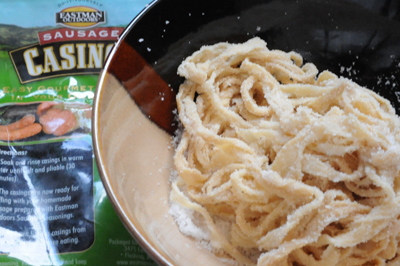 |
| Smelly sausage casings packed in salt. |
So the first thing you need to do is soak the casings. Depending on who you ask, this takes anywhere from five to 30 minutes. Definitely just go by what the package tells you (mine said to soak for 30 minutes, and this seemed to work out fine). When the soak is done, first stop up your sink because you'll be mad if you drop your casings down the garbage disposal. Then find the end of the casing and gently figure out how to open it. It's kind of like the end of a balloon, only way more fiddly. Once you've found the opening, turn on your faucet and run the water through the casing to make sure all the salt comes out of it and to check for leaks. If you do see a leak you'll need to cut the casing where you find it.
To make the filling, first you need to boil the cabbage until it becomes soft. Meanwhile, cube the pork. Don't try to trim the fat out of it, because good sausage needs a lot of fat. Finally, chop the onion.
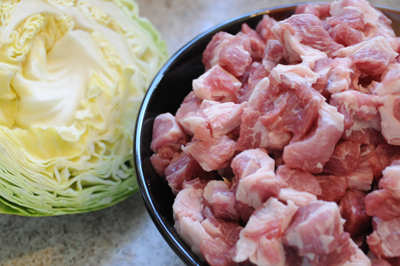 |
| Your pork should be pretty fatty--good sausage needs fat. |
When the cabbage is done let it drain and cool. Cut the cooked cabbage into smaller pieces and mix it up with the onion and the pork.
Now sit down with your meat grinder and run the mixture through it. This is really tedious and, if you have a manual grinder like mine, also somewhat painful. When you're finally done you'll have a mountain of sausage filling. Add the seasonings and mix well.
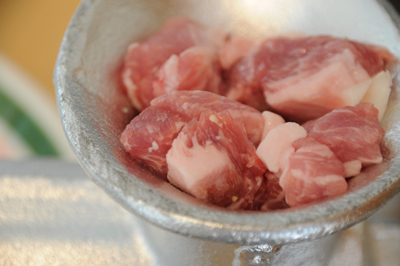 |
| Pork goes in ... |
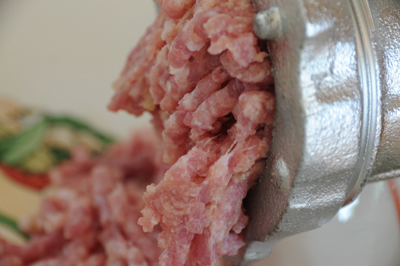 |
| ... sausage comes out! |
Next you'll need to use the sausage attachment on your meat grinder, which basically is a tube assembly that replaces the blades. Get your prepared casings out of the fridge and find the ends again. Put one end on the tube and tie a knot at the other end. Now slip the rest of the casing onto the tube until most of it is bunched up around the plastic.
This is where the casings kind of surprised me; I expected them to be easy to tear but they were actually quite tough. If you're patient and you don't force them, it's actually kind of hard to damage them.
Once you've got the casings on the tube, start turning the handle. You may need to gently squeeze and shape the casings as they fill to make sure that there aren't any air pockets and that the sausages end up being the right shape. When you get about four inches of filling into the first sausage, twist it a few times to make a link. Then fill up the next sausage. Keep going until you either run out of casings or filling, then make another knot. You're done! Yay!
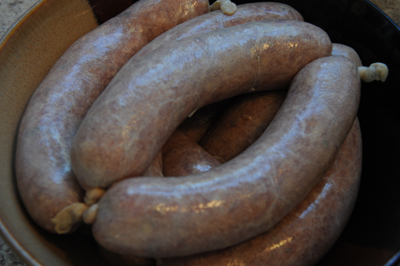 |
| These sausages just need to be cooked. |
To cook the sausages, just put them in a single layer in the bottom of a large stock pot and cover them with water. Bring to a simmer, reduce heat just enough to maintain a simmer and cover (the sausages may burst if you cook them any hotter than that). Simmer for 15 minutes, then remove from the heat and let rest for another 15 minutes.
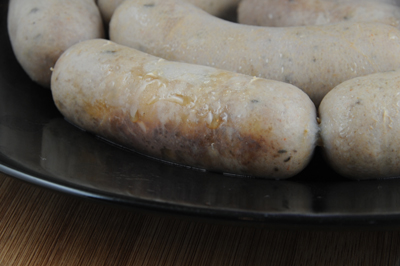 |
| If you like them browned, finish them in a grill pan before serving. |
If you're parinoid like me, you might want to check the internal temperature of one of the sausages with a meat thermometer (it should read at least 160) just before you take it off the heat. When I did this, though, oil shot up in a spout that was probably about two feet high, making a mess of my stove. So stand back.
At some point during this process you'll want to start making the stoemp, which depending on your preference could take anywhere from about 20 minutes to 2 1/2 hours. Here's how it's done:
First boil the potatoes with the salt. Drain and run through a ricer or mash.
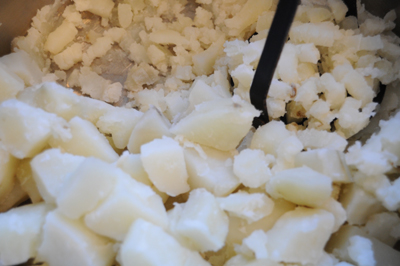 |
| If you don't have a ricer, just mash the potatoes. |
Meanwhile, rinse the leeks (leeks are really dirty, so make sure to rinse them well) and slice them into rings. Melt the butter in a large pan and add the leek slices. Cook for five minutes or until soft, continuing to stir (you don't want them to brown).
 |
| Saute the leeks in butter. |
Add the chicken stock, the cream, the nutmeg and salt and pepper to taste.
 |
| Then add the cream, chicken stock and spices. |
Bring just to a boil, then reduce heat and simmer for 15 minutes. Strain off the liquid, reserving it, and add the leeks to the potatoes. Return the sauce to the pan and bring it back to a boil. Continue to boil, stirring continuously, until the sauce is reduced by half. Then add it to the mashed potatoes (you can also add some extra butter and cream if the mixture is too dry). Turn the stoemp into a baking dish and bake at 300 degrees for 2 hours.
Note: the oven part of stoemp-making is different depending on which recipe you use. I found other stoemp recipes that don't call for any oven time at all. The baking basically gives the stoemp a nice crispy crust, which I rather liked (I only baked mine for about an hour so it could have been a bit crispier).
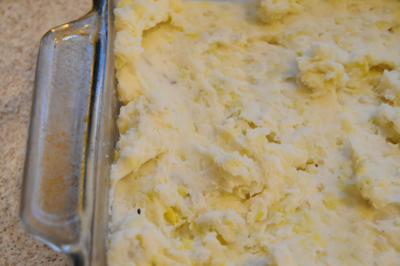 |
| Stoemp can be served immediately or baked to give it a crispy top layer. |
Now on to the Brussels sprouts, which really couldn't be easier:
Put the sprouts in a pan and add the beer. Bring to a boil. Boil for about 20 minutes, or until the sprouts are tender.
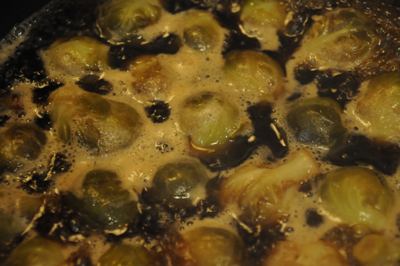 |
| Just boil the sprouts in beer. |
Drain off the beer and add the butter to the pan. Stir until the butter is melted and it coats the sprouts. Done!
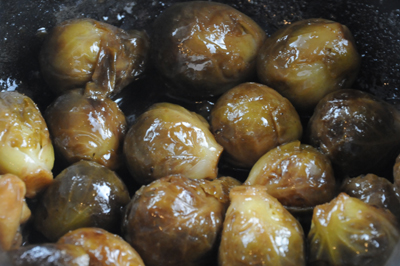 |
| Drain the beer and add melted butter. |
At some point you'll also need to start making the pear syrup and prepping the cheese croquettes, which are actually pretty easy to make but need to be timed just right so they'll be hot and crispy when you serve them. I actually ran out of time so I ended up doing mine as an after-dinner snack instead of an appetizer.
To make the syrup, boil the water and sugar with the lemon zest for about five minutes.
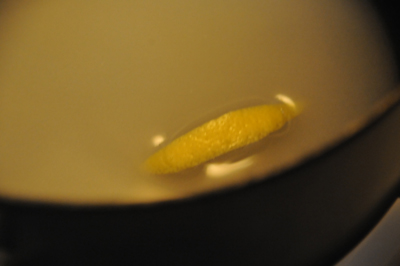 |
| This is the lemon zest in the sugar water. Lousy picture, I know. |
Then add the pears, cut side down, and continue to boil for 8 minutes longer.
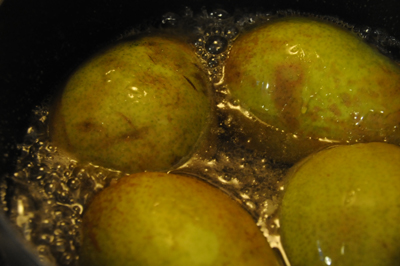 |
| Add the pears and boil. |
Using a slotted spoon, remove the pears and lemon zest and set aside (I gave them to my kids as a dessert).
First a quick note: "Abbey" cheese is a kind of Belgian cheese, and you're not likely to find it at Safeway. I got mine from iGourmet.com (where it's called "Brigid's Abbey," a brand that doesn't come directly from Belgium but is made from a Belgian recipe). The cheese I got tasted a little bleu, although I don't know if that's what it's supposed to taste like or if it's more because my cheese took an extra day to arrive because of weather-related delays at UPS.
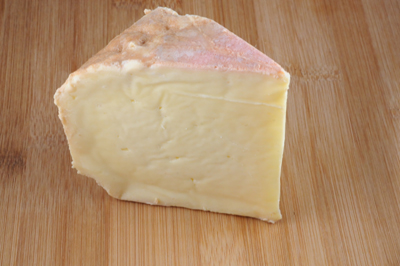 |
| Abbey cheese is a soft white cheese made from raw cow's milk. |
To make the croquettes, cut the cheese up into little mini wedges, or just in small slices. Then coat each piece completely in flour.
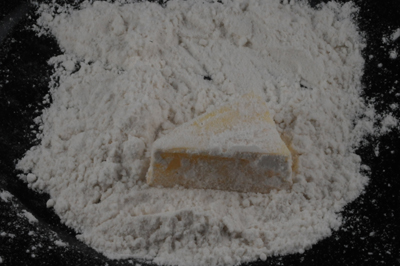 |
| Coat the cheese wedges with flour. |
Dip in the beaten egg, then coat with breadcrumbs. Repeat until all the cheese wedges are coated.
 |
| Dip in egg, then coat with breadcrumbs. |
Heat two inches of oil over a hot stove (the oil is ready when bubbles rise around the non-stirring end of a wooden spoon). Drop the breaded cheese into the oil, taking care to keep them separate so they don't stick. Fry until they are a golden color, which doesn't really take any time at all (less than a minute). Drain on paper towels and serve with the pear syrup as a dipping sauce (you may need to add a little water to the syrup to thin it).
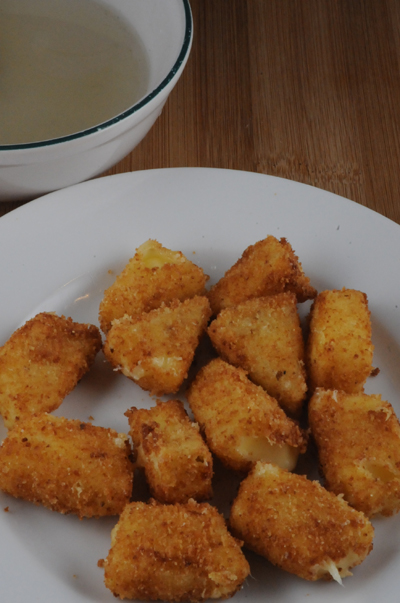 |
| When golden, drain on a paper towel and serve with pear syrup. |
So anyway, I think my kids are Belgian. I couldn't believe the speed at which two pounds of sausage and a batch of stoemp were consumed. Everyone wanted seconds, even picky Hailey. I thought the sausages were pretty good for someone who's never made sausages, and was still marveling that I hadn't screwed them up by the time I got them on the table. I liked the stoemp, too, even though it really was just a fancy mash. The Brussels sprouts, though, ew. No one liked them. Brussels sprouts are sort of naturally bitter and adding the dark beer made them even more so. I ended up throwing quite a few of them away.
The cheese croquettes, on the other hand, came together quickly and were really tasty with the pear syrup. You could probably use any cheese to do these--and I may never eat another boring fried mozzarella ball again.
Martin was less impressed. Evidently, he doesn't like sausage. Which is a weird thing to hear from a guy who puts linguicia in the Thanksgiving stuffing and hot Italian sausages on the barbecue. So who knew. Also he was kind of annoyed at me for serving the cheese croquettes after dinner, because I guess I led him to believe he was going to get a dessert, probably based on the fact that I called it "dessert."
Guess I should have done something with chocolate.
Next week: Belize
For printable versions of this week's recipes:











This is a great post, I favorited your blog and added your feed. Cheap Dorms St.Kilda
ReplyDeleteThanks! Glad you're enjoying.
ReplyDelete